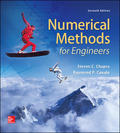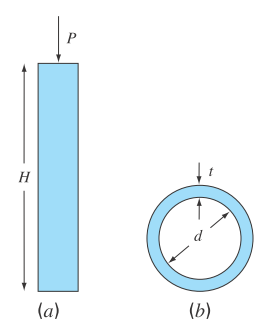
Concept explainers
Suppose that you are asked to design a column to support a compressive load P, as shown in Fig. P16.16a. The column has a cross-section shaped as a thin-wall edpipe as shown in Fig. P16.16b.
The design variables are the mean pipe diameter d and the wall thickness t. The cost of the pipe is computed by
where
where
Actual stress (
Actual stress
The actual stress is given by
The buckling stress can be shown to be
where
Finally, diameters of available pipes are between

FIGURE P16.16
(a) A column supporting a compressive load P. (b) The column has a cross section shaped as a thin-walled pipe.
Want to see the full answer?
Check out a sample textbook solution
Chapter 16 Solutions
EBK NUMERICAL METHODS FOR ENGINEERS
- rounded to two decimal places at each calculationarrow_forwardUse Variation of Parameters to solvearrow_forwardMoment of a Force 2.14 Ma= Does Box Tip Over?=- 2.15 (change beam weight to 900 N)) X= 2.17 P= Varignon's Theorem 2.19 (change story height to 5m) Ma= 2.21 MA=. MB=_ 2.23 (change maximum tension to 2500 lbs) W= Couple and Moment of a Couple 2.24 MA=. MB=_ 2.26 (change force to 110 KN) F= M= Answer all parts, please.arrow_forward
- read chapter 10 welding principles and applications, short-circuiting, transfer, GMAW – S. Explain why the power supply is critical in the short-circuiting transfer process. Discuss what happens if there’s too much or two little inductance.arrow_forwarda. Find the general flow pattern of the network shown in the figure. b. Assuming that the flow must be in the directions indicated, find the minimum flows in the branches denoted by X2, X3, X4, and x5 a. Choose the correct answer below and fill in the answer boxes to complete your choice. OA. x₁ = X2 is free X3 is free B. X₁ is free x2= ×4 is free X5 is free X6 = X3= X4 X5 X6 = 11 = ○ C. D. X2 is free X3= X4 is free X5 is free x2 = 0 X3 is free ×4 = X6 is free gave 20 30 12 C 804 60-> B <<90 314 X4D -80 E T 20 40 xarrow_forwardConsider an economy with three sectors, Chemicals & Metals, Fuels & Power, and Machinery. Chemicals sells 30% of its output to Fuels and 60% to Machinery and retains the rest. Fuels sells 70% of its output to Chemicals and 20% to Machinery and retains the rest. Machinery sells 40% of its output to Chemicals and 30% to Fuels and retains the rest. Complete parts (a) through (c) below a. Construct the exchange table for this economy. Distribution of Output from: Chemicals Fuels Machinery (Type integers or decimals.) Purchased by: Chemicals Fuels Machineryarrow_forward
- Algebra & Trigonometry with Analytic GeometryAlgebraISBN:9781133382119Author:SwokowskiPublisher:Cengage
 Functions and Change: A Modeling Approach to Coll...AlgebraISBN:9781337111348Author:Bruce Crauder, Benny Evans, Alan NoellPublisher:Cengage Learning
Functions and Change: A Modeling Approach to Coll...AlgebraISBN:9781337111348Author:Bruce Crauder, Benny Evans, Alan NoellPublisher:Cengage Learning Glencoe Algebra 1, Student Edition, 9780079039897...AlgebraISBN:9780079039897Author:CarterPublisher:McGraw Hill
Glencoe Algebra 1, Student Edition, 9780079039897...AlgebraISBN:9780079039897Author:CarterPublisher:McGraw Hill  College AlgebraAlgebraISBN:9781305115545Author:James Stewart, Lothar Redlin, Saleem WatsonPublisher:Cengage Learning
College AlgebraAlgebraISBN:9781305115545Author:James Stewart, Lothar Redlin, Saleem WatsonPublisher:Cengage Learning Algebra and Trigonometry (MindTap Course List)AlgebraISBN:9781305071742Author:James Stewart, Lothar Redlin, Saleem WatsonPublisher:Cengage Learning
Algebra and Trigonometry (MindTap Course List)AlgebraISBN:9781305071742Author:James Stewart, Lothar Redlin, Saleem WatsonPublisher:Cengage Learning Algebra: Structure And Method, Book 1AlgebraISBN:9780395977224Author:Richard G. Brown, Mary P. Dolciani, Robert H. Sorgenfrey, William L. ColePublisher:McDougal Littell
Algebra: Structure And Method, Book 1AlgebraISBN:9780395977224Author:Richard G. Brown, Mary P. Dolciani, Robert H. Sorgenfrey, William L. ColePublisher:McDougal Littell





